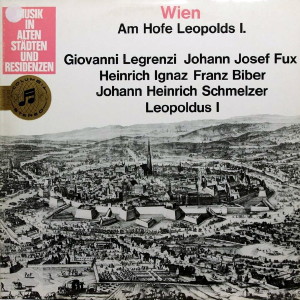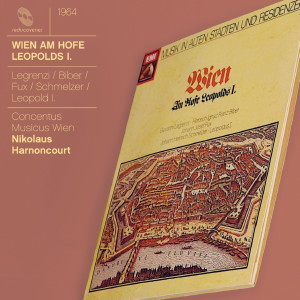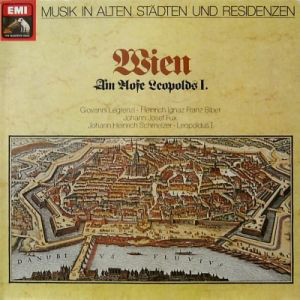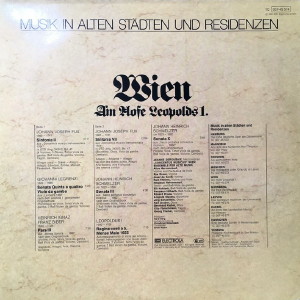 |
1 LP -
91 115 - (p) 1964
|
 |
| 1 CD -
50999 6025112 1 - (c) 2012 |
|
| Wien - Am Hofe Leopolds I. |
|
|
|
|
|
|
|
| Johann Josef Fux
(1660-1741) |
|
|
|
| Sinfonia II - Concentus
musico-instrumentalis, 1701 |
|
16' 11" |
A1 |
| - Allegro assai - Grave -
Allegro - Adagio |
4' 51" |
|
|
| - Libertein |
1' 46" |
|
|
| - Entrée |
2' 03" |
|
|
| - Menuet |
1' 43" |
|
|
| - Passepied |
1' 00" |
|
|
| - Ciacona |
5' 09" |
|
|
(4 violins, 3
oboes, tenor viola da gamba, bass viola
da gamba, violone, bassoon, harpsichord)
|
|
|
|
| Giovanni Legrenzi
(1626-1690) |
|
|
|
| Sonata Quinta a quattro viole
da gamba - La Cetra, 1673/1682 |
|
5' 35" |
A2 |
| (pardessus de
viole, tenor viola da gamba, 2 bass
viole da gamba, violone) |
|
|
|
| Heinrich Ignaz Franz von
Biber (1644-1704) |
|
|
|
| Pars III - Mensa
sonora, 1680 |
|
7' 55" |
A3 |
- Gagliarda: Allegro
|
1' 15" |
|
|
- Aria
|
2' 36" |
|
|
- Ciacona
|
3' 21" |
|
|
| - Sonatina |
0' 54" |
|
|
(violin, viola,
tenor viola da gamba, bass viola da
gamba, violone, harpsichord)
|
|
|
|
| Johann Josef Fux
(1660-1741) |
|
|
|
| Sinfonia VII - Concentus
musico-instrumentalis, 1701 |
|
12' 06" |
B1 |
- Adagio - Andante - Allegro
|
6' 20" |
|
|
- La joye des fidels suject:
Allegro
|
1' 55" |
|
|
- Aria italiana - Aire françoise
|
2' 31" |
|
|
| - Les enemis confus |
1' 36" |
|
|
(recorder,
oboe, viola da gamba, harpsichord)
|
|
|
|
| Johann Heinrich Schmelzer
(c.1623-1680) |
|
|
|
| Sonata III - Sacro-profanus
concentus musicus, 1662 |
|
4' 46" |
B2 |
(2 violins,
viola, tenor viola da gamba, 2 bass
viole da gamba, violone, harpsichord)
|
|
|
|
| Leopold I (1640-1705) |
|
|
|
Regina coeli à 5,
Mense Maio 1655 - Accompagnamento di
viole del Antonio Bertali (edition by
Guido Adler) *
|
|
7' 25" |
B3 |
(alto voice, 2
violins, tenor viola da gamba, 2 bass
viole da gamba, violene, harpsichord)
|
|
|
|
Johann Heinrich Schmelzer
|
|
|
|
| Sonata X - Sacro-profanus
concentus musicus, 1662 |
|
3' 57" |
B4 |
(violin, viola,
tenor viola da gamba, bass viola da
gamba, violone, harpsichord)
|
|
|
|
|
|
|
|
Jeanne Deroubaix,
mezzo-soprano *
|
|
Concentus Musicus
Wien, Ensemble für Alte Musik
|
|
| -
Alice Harnoncourt, violin,
pardessus de viole |
-
Eduard Hruza, violone |
|
| -
Eva Braun, violin |
-
Leopold Stastny, recorder |
|
| -
Josef de Sordi, violin |
-
Jürg Scaheftlein, oboe |
|
-
Kurt Theiner, violin, viola
|
-
Karl Gruber, oboe |
|
| -
Nikolaus Harnoncourt, tenor and
bass viola da gamba |
-
Bernhard Kiebel, oboe |
|
| -
Elli Kubizek, bass viola da gamba |
-
Otto Fleischmann, bassoon |
|
| -
Hermann Höbarth, bass viola da
gamba |
-
Georg Fischer, harpsichord |
|
| Nikolaus
Harnoncourt, conductor |
|
|
Luogo e data
di registrazione
|
Sinfonia-Studio, Vienna
(Austria) - 16-21 giugno 1963
|
|
Registrazione
live / studio
|
| studio |
Producer / Engineer
|
Gerd Berg / Ernst Rothe
|
Prima Edizione
CD
|
EMI Records Ltd / Virgin
Classics - 50999 6025112 1 - (1 cd) -
59' 11" - (c) 2012 - ADD
|
Prima
Edizione LP
|
EMI Electrola GmbH - 91 115 -
(1 lp) - 59' 11" - (p) 1964
|
|
|
Notes on the program
|
|
Anyone with an interest
in music acknowledges Vienna to be one
of the major centres of the art: after
all, the concert repertoire is even
today dominated by the three great
masters of Viennese classical music.
What is less well kown is that Vienna
was already an important musical centre
long before the classical era, even
though it was only during the later
period that it was universally
recognised as a city of music.
One of the most fascinating phenomena in
music history is the way in which
particular countries and regions give
birth to specific forms and styles,
developing their own creative strengths.
For no apparent reason, different places
achieve international renown, then after
a few generations of intense creative
energy fall back to a more normal level,
as though they had burnt thenselves out.
Pratically all European countries have
at one time or another - and in many
cases more than once - enjoyed "golden
ages" as powerhouses of musical
activity. These centres of music were by
no means always simultaneously great
centres of political power, though there
is often a close correlation between the
two. Franco-Flemish music, for exemple,
enjoyed a great flowering round about
1500, at the same time as the courts of
the French king Louis XII and of the
German Holy Roman Emperor Maximilian I
were at the height of their political
dominance and magnificence. Although
Vienna, as one of the supreme cultural
centres in the German-speaking world and
as the place of residence both of the
Babenbergs and of the Habsburgs, had
always had a thriving musical tradition,
lor many years this was dominated by
foreign artists, and it was a while
before the city found its own
characteristic mode of expression. For
three hundred years Vinna was a
melting-pot in which the most diverse
stylistic tendencies came together. Over
the course of the centuries,
representatives of different creative
traditions to a certain extent met here
on neutral ground; it was possible to
hear Dutch, Italian. English and French
musicians in the city. To these were
added eastern influences as a result of
Vienna’s close connections with Slavonic
and Magyar culture. This exposure to the
entire musical world enabled the
Viennese (and Austrians in general),
with their natural musical gifts, to
develop their own distinctive style. The
vigorous folk music traditions of
Austria, Hungary and Bohemia played an
important role from the very beginning,
and it was not until the time of Leopold
I, in the second half of the seventeenth
century, when home-grown masters such as
Schmelzer and Fux were for the first
time in charge ol musical activities at
the imperial court, that the music
composed there acquired an unmistakably
Viennese and Austrian character.
Opera, the great musico-dramatic novelty
of the early seventeenth century,
arrived in the Austrian capital as a
consequence of its close political ties
with Italy, and immediately enjoyed an
enthusiastic reception. Vienna was a
leading centre of Italian opera in the
seventeenth century, and practically all
the important Italian opera composers
worked there. Their operas also offered
an opportunity to hear a great deal of
purely instrumental music.
ln addition to dance numbers provided by
ballet composers there were instrumental
interludes, and instrumental concertos
were also frequently inserted into
operas. The dance numbers were based
mainly on French models; many dances,
however, drew on native melodic
material, as can be seen from titles
such as Sleyermärker
Horn, Gavotta tedesca,
Gavotta styryaca
and Böhmischer
Dudelsack. The instrumental
interludes were the work of the Italian
opera composers themselves. These
interludes were often given the title
"Sonata"; the earlier ones were
generally written for five instruments
and their form was taken directly
fromthe old Italian Canzoni
da sonar. These polyphonic
"sonatas" should not be confused with
the solo sonata of the classical era.
Italian opera composers also wrote
sacred music for the main churches in
Vienna.
It is not surprising that Austrian
composers such as Schmelzer, Fux and
Biber were closely acquainted with the
Italian style in all areas of
composition. France, on the other hand,
resisted importing Italian opera, and
the French created their own special
dance form for inclusion in operatic
works: the ballet de cour. From
this, Lully developed the typical French
opera in the second half of the
seventeenth century, distinguished from
Italian opera in particular by its
greater emphasis on the ceremonial
aspect, its formal dance sequences and
its respect for the metrical values of
the text. There are no purely musical
numbers in which the text plays a
subordinate role (as it does in the
arias of Italian opera), and the
instrumental pieces are invariably
dances. Lully’s reforms of French opera,
especially those relating to the style
and technique of the orchestral part,
caused a sensation throughout Europe.
The instmmental suites taken from his
operas, with their new kind of overture
and graceful French dances, were highly
popular not only in Paris; they were
soon also imitated throughout Germany
and England. The short and precise
bowing style of the violins in Lully's
orchestra - absolutely essential for an
authentic performance of French music -
is worlds apart from the cantabile and
legato playing style of the Italians.
Many German courts engaged French
musicians, though in some places Italian
violinists refused to play French music.
Vienna too became acquainted with the
latest French music at an early date,
from about 1665 onwards.
During the reign of Leopold I, the
French suite and the Italian sonata
represented stylistic opposite poles in
instrumental music. The French suite
stnctly speaking arose as an imitation
ot the extraordinarily popular dance
suites derived from Lully‘s operas and
was developed into an independent
musical genre by other composers; Lully
himself did not write any "suites'" The
ltalian sonata was a formally free,
single-movement instrumental piece
evolved from the old Canzon da sonar.
What was considered elsewhere to be the
incompatibility of these two stylistic
tendencies was in Austria blended into a
new and fascinating unity by brilliant
composers such as Muffat, Fux and Biber.
Muffat was the only composer to set down
his thoughts on these stylistic
questions and I will say a few words
about him here, though his music does
not in fact leature on this recording.
He studied with Lully in Paris, then
went to the Viennese court where he
enjoyed the protection of Leopold I,
later becoming court composer to the
Archbishop of
Salzburg. He described himself as the
first German "Lyllist". However, the
Archbishop of Salzburg sent him to ltaly
to complete his education. There he
wrote concerti grossi in the
style of Corelli, and the following
eloquent passage appears in the foreword
to these works: "I have sought to
moderate Italian depth of feeling with
French lightness and charm in such a way
that the one might not be too dark and
pompous, nor the other too free and
unbridled. lt is an apt symbol of Your
Esteemed Grace’s lofty virtue and
disposition... I first had the idea of
creating such an ingenious blend some
time ago in Rome, where I was learning
to play the keyboard in the ltalian
style under the world-famous Bernardo
Pasquini, when I heard with great
delight and amazement some concertos by
the masterly Arcangelo Corelli performed
most beautifully and with the utmost
accuracy by a great number of
instrumentalists..." In the dedication
to his Florilegium Primum
Muffat wrote: "However, just as the
first attraction of gardens is the
diversity of plants and flowers, and as
the excellence and general felicity of
great heroes seems to result from many
intertwined virtues, I have concluded
that in the obedient service which Your
Esteemed Grace, as a prince of wisdom
and virtue, deserves, it is fitting to
employ not just one style, but a mixture
of styles skilfully assembled from
various countries. From Your Esteemed
Grace, whose consummate understanding is
derived from long experience with the
court and business, I have no tear of
the impudent attacks of those malicious
or weak souls who condemn me. As I
received my earliest training in France
at the hands ot the most experienced
masters of this art, I realise that the
charge of inclining more towards that
nation than is appropriate could be laid
against me, and in this time of war with
France I could be considered unworthy of
receiving a favourable hearing from the
Germans. Truly I have other thoughts
than: Aere ciere viros, Martemque
accendere cantu [To spur on the
sound of arms, or to encourage the god
Mars to join battle]. The weapons of war
and the reasons for them are far from
me; notes, strings and the delightful
sounds of music dictate my course, and
in combining the French manner with the
German and the Italian, I do not
instigate conflict, but perhaps rather
look forward to the unity, the dear
peace, desired by the peoples..."
Muffat was thus the first composer to
use the two opposing styles as a symbol
of European reconciliation. This
reconciliation should be understood in
the light of the bitter political enmity
between Louis XIV and Leopold I, which
threatened to push the two very
different peoples even further apart
culturally. Muffat‘s close connections
with the Viennese court as well as his
relationship with Biber, his deputy
Kapellmeister at Salzburg, eventually
produced a peaceful fusion of Italian
and French styles in Austrian music. Of
course, Muffat was not the only one
whose journey to the Viennese court was
made via French music. There were many
French performers who disseminated
knowledge of the latest developments in
their homeland during their Europe-wide
tours, and musicians employed by the
imperial court would have had regular
opportunities to visit courts in
southern Germany, where the French
influence was more pronounced. Although
Leopold himself had a profound antipathy
towards a purely French compositional
style, especially in dance music, his
composers increasingly incorporated
French elements into their music.
ln many of the suites written by Muffat,
Fux, Biber and other composers, the
influence of the ltalian school is
apparent from their introductory
movements (sinfonias), but can also be
heard occasionally within the context of
formal French overtures. interspersed
with the mainly French-inspired dance
movements are free, often slow movements
written in the ltalian style, in
addition to these, many suites contain -
as if to provide a touch of the exotic -
lively dances unmistakably inspired by
native folk music. But these typically
Austrian suites are in no way a motley
collection of heterogeneous styles - the
great achievement of the composers lay
in the fact that they succeeded in
creating a new and valid whole out of
these eclectic elements and influences.
All the Austrian instrumental composers
from the time of Leopold I wrote Sonatas
and suites. Unlike their Italian and
French colleagues, they thus cultivated
both styles. The main aspect that they
borrowed from these two spheres of
influence was the form; as far as the
melodic material was concerned, German,
Hungarian and Bohemian elements often
made an appearance. So for example, one
of the sonatas in Schmelzer's Concentus
musicus begins with a typical
czardas motif that is still familiar
today, and the (French) suites of all
the Austrian composers are interspersed
with totally un-Gallic dances and ideas.
To sum up, one could say that in Vienna
the Italian manner was officially in the
ascendancy, but that a new and
distinctive style arose out of the
contact between Italian and French
styles of composition and the Austrians'
natural gift for
music.
Nikolaus
Harnoncourt, 1964 (translation:
Paula Kennedy, 2012)
|
|
Instrumentarium
|
|
- Violine, Jacobus
Stainer, Absam, 1658
- Violine, Jacobus Stainer, Absam, 1677
- Violine, Klotz, Mittenwald, 18. Jh.
- Violine, Klotz, Mittenwald, 18. Jh.
- Viola, Marcellus Hollmayr, Wien 17.
Jh.
- Pardessus de Viole, Ludovicus Guersan,
Paris, 1742
- Tenor Viola da
Gamba, Brescia, um 1580
-
Bass Viola da Gamba, Jacob
Prescheisn, Wien 1670
- Bass Viola da
Gamba, deutsch, um 1760
- Violone, Antony Stefan Posch,
Wien 1731
- Blockflöte, Kopie von H. C.
Fehr, Zürich
- Oboe, P. Paulhahn, Anfang des
18. Jh.
- Oboe, J. Bauer, Wien, 18. Jh.
- Oboe, Kopie von O. Steinkopf,
Berlin
- Fagott, Wien 18. Jh.
- Cembalo, Kopie eines ital.
Kielflügels um 1700 von M.
Skowroneck
|
|
Other Editions
|
  |
| - EMI His
Master Voice "Musik in Alten Städten und
Residenzen" - 1C 037-45 574 - 1 LP -
(c) 19?? |
|
|
|
Nikolaus
Harnoncourt (1929-2016)
|

|

|
|